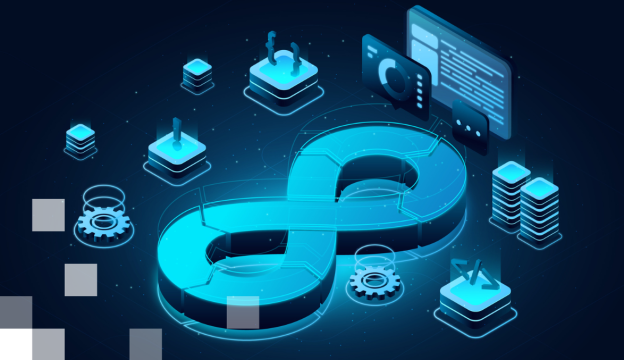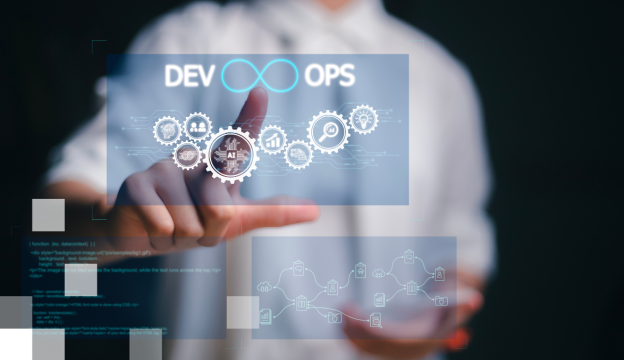Designing and Implementing Microsoft DevOps solutions
This course provides the knowledge and skills to design and implement DevOps processes and practices. During this course you are going to learn how to plan DevOps, use source control, scale Gitfor enterprise, consolidate artifacts, develop a dependency management strategy, manage secrets, implement continuous integration, implement a containerization strategy, develop a release strategy, set up a release management workflow, implement a deployment model and optimize feedback mechanisms.
EU co-financing of 50-100% is available to companies.
The total cost of tuition may vary depending on the rules of the specific association.
Plans
Contact us
Apply or ask a question!
If you want to apply for the course or ask a question about it, feel free to use this form. |
||||||||||||||||
|
||||||||||||||||
Course target
Provide an understanding of the key principles and practices of DevOps, including:
- continuous integration;
- continuous delivery;
- continuous deployment.
The course covers a range of Azure DevOps services and tools, including Azure Boards for work item tracking, Azure Repos for source control management, and Azure Pipelines for build and release management.
Audience
Professionals who are interested in implementing DevOps processes and anyone who wants to pass a Microsoft Azure DevOps Solutions certification exam with the aim of obtaining internationally recognized certificate.
At Course Completion you will be able to:
- Plan for the transformation with shared goals and timelines.
- Select a project and identify project metrics and KPIs.
- Create a team and Agile organization structure.
- Describe the benefits of using Source Control.
- Migrate from TFVC to Git.
- Scale Git for Enterprise DevOps.
- Recommend artifact management tools and practices.
- Abstract common packages to enable sharing and reuse.
- Migrate and consolidate artifacts.
- Migrate and integrate source control measures.
- Manage application config and secrets.
- Develop a project quality strategy.
- Plan for secure development practices and compliance rules.
- Implement and manage build infrastructure.
- Explain why continuous integration matters.
- Implement continuous integration using Azure DevOps.
- Manage code quality including technical debt, SonarCloud, and other tooling solutions.
- Manage security policies with open source, OWASP, and WhiteSource Bolt.
- Implement a container strategy including how containers are different from virtual machines and how microservices use containers.
- Implement containers using Docker.
- Inspect open source software packages for security and license compliance to align with corporate standards.
- Configure build pipeline to access package security and license rating.
- Configure secure access to package feeds.
- Inspect codebase to identify code dependencies that can be converted to packages.
- Identify and recommend standardized package types and versions across the solution.
- Refactor existing build pipelines to implement version strategy that publishes packages.
- Manage security and compliance.
- Differentiate between a release and a deployment.
- Define the components of a release pipeline.
- Explain things to consider when designing your release strategy.
- Classify a release versus a release process and outline how to control the quality of both.
- Describe the principle of release gates and how to deal with release notes and documentation
- Explain deployment patterns, both in the traditional sense and in the modern sense.
- Choose a release management tool.
- Explain the terminology used in Azure DevOps and other Release Management Tooling.
- Describe what a Build and Release task is, what it can do, and some available deployment tasks.
- Classify an Agent, Agent Queue, and Agent Pool.
- Explain why you sometimes need multiple release jobs in one release pipeline.
- Differentiate between multi-agent and multi-configuration release job.
- Use release variables and stage variables in your release pipeline.
- Deploy to an environment securely using a service connection.
- Embed testing in the pipeline.
- List the different ways to inspect the health of your pipeline and release by using alerts, service hooks, and reports.
- Create a release gate.
- Describe deployment patterns.
- Implement Blue Green Deployment.
- Implement Canary Release.
- Implement Progressive Exposure Deployment.
- Configure crash report integration for client applications.
- Develop monitoring and status dashboards.
- Implement routing for client application crash report data.
- Implement tools to track system usage, feature usage, and flow.
- Integrate and configure ticketing systems with development team’s work management.
- Implement a mobile DevOps strategy.
- Apply infrastructure and configuration as code principles.
- Deploy and manage infrastructure using Microsoft automation technologies such as ARM; templates, PowerShell, and Azure CLI.
- Describe deployment models and services that are available with Azure.
- Deploy and configure a Managed Kubernetes cluster.
- Deploy and configure infrastructure using 3rd party tools and services with Azure, such as Chef, Puppet, Ansible, SaltStack, and Terraform.
- Define an infrastructure and configuration strategy and appropriate toolset for a release pipeline and application infrastructure.
- Implement compliance and security in your application infrastructure.
- Design practices to measure end-user satisfaction.
- Design processes to capture and analyze user feedback from external sources.
- Design routing for client application crash report data.
- Recommend monitoring tools and technologies.
- Recommend system and feature usage tracking tools.
- Analyze alerts to establish a baseline.
- Analyze telemetry to establish a baseline.
- Perform live site reviews and capture feedback for system outages.
- Perform ongoing tuning to reduce meaningless or non-actionable alerts.
Prerequisites
Fundamental knowledge about Azure, version control, Agile software development, and core software development principles. It would be helpful to have experience in an organization that delivers software.
Training materials
Training materials available in the Microsoft Learn environment.
Certification Exam
AZ-400: Microsoft Azure DevOps Solutions (the exam fee is already included in the course price).
Course outline
1. Planning for DevOps
- Transformation Planning;
- Project Selection;
- Team Structures;
- Migrating to Azure DevOps.
2. Getting started with Source Control
- What is Source Control;
- Benefits of Source Control;
- Types of Source Control Systems;
- Introduction to Azure Repos;
- Introduction to GitHub;
- Migrating from Team Foundation Version Control (TFVC) to Git in Azure Repos;
- Authenticating to Git in Azure Repos.
3. Scaling Git for enterprise DevOps
- How to Structure your Git Repo;
- Git Branching Workflows;
- Collaborating with Pull Requests in Azure Repos;
- Why care about GitHooks;
- Fostering Inner Source.
4. Consolidating Artifacts & Designing a Dependency Management Strategy
- Packaging Dependencies;
- Package Management;
- Migrating and Consolidating Artifacts.
5. Implementing Continuous Integration with Azure Pipelines
- The concept of pipelines in DevOps;
- Azure Pipelines;
- Evaluate use of Hosted vs Private Agents;
- Agent Pools;
- Pipelines and Concurrency;
- Azure DevOps and Open Source Projects (Public Projects);
- Azure Pipelines YAML vs Visual Designer;
- Continuous Integration Overview;
- Implementing a Build Strategy;
- Integration with Azure Pipelines;
- Integrate External Source Control with Azure Pipelines;
- Set Up Private Agents;
- Analyze and Integrate Docker Multi-Stage Builds.
6. Managing Application Config and Secrets
- Introduction to Security;
- Implement secure and compliant development process;
- Rethinking application config data;
- Manage secrets, tokens, and certificates;
- Implement tools for managing security and compliance in a pipeline.
7. Managing Code Quality and Security Policies
- Managing Code Quality;
- Managing Security Policies.
8. Implementing a Container Build Strategy
- Implementing a Container Build Strategy.
9. Manage Artifact versioning, security & compliance
- Package security;
- Open source software;
- Integrating license and vulnerability scans;
- Implement a versioning strategy (Git version).
10. Design a Release Strategy
- Introduction to Continuous Delivery;
- Release strategy recommendations;
- Building a High-Quality Release pipeline;
- Choosing a deployment pattern;
- Choosing the right release management tool.
11. Set up a Release Management Workflow
- Create a Release Pipeline;
- Provision and Configure Environments;
- Manage and Modularize Tasks and Templates;
- Integrate Secrets with the release pipeline;
- Configure Automated Integration and Functional Test Automation;
- Automate Inspection of Health.
12. Implement an appropriate deployment pattern
- Introduction to Deployment Patterns;
- Implement Blue Green Deployment;
- Feature Toggles;
- Canary Releases;
- Dark Launching;
- AB Testing;
- Progressive Exposure Deployment.
13. Implement process for routing system feedback to development teams
- Implement Tools to Track System Usage, Feature Usage, and Flow;
- Implement Routing for Mobile Application Crash Report Data;
- Develop Monitoring and Status Dashboards;
- Integrate and Configure Ticketing Systems.
14. Implement a mobile DevOps strategy
- Introduction to Mobile DevOps;
- Introduction to Visual Studio App Center;
- Manage mobile target device sets and distribution groups;
- Manage target UI test device sets;
- Provision tester devices for deployment;
- Create public and private distribution groups.
15. Infrastructure and Configuration Azure Tools
- Infrastructure as Code and Configuration Management;
- Create Azure Resources using ARM Templates;
- Create Azure Resources using Azure CLI;
- Create Azure Resources by using Azure PowerShell;
- Desired State Configuration (DSC);
- Azure Automation with DevOps;
- Additional Automation Tools.
16. Azure Deployment Models and Services
- Deployment Modules and Options;
- Azure Infrastructure-as-a-Service (IaaS) Services;
- Azure Platform-as-a-Service (PaaS) services;
- Serverless and HPC Computer Services;
- Azure Service Fabric.
17. Create and Manage Kubernetes Service Infrastructure
- Azure Kubernetes Service.
18. Third Party Infrastructure as Code Tools available with Azure
- Chef;
- Puppet;
- Ansible;
- Terraform.
19. Implement Compliance and Security in your Infrastructure
- Security and Compliance Principles with DevOps;
- Azure security Center.
20. Recommend and design system feedback mechanisms
- The inner loop;
- Continuous Experimentation mindset;
- Design practices to measure end-user satisfaction;
- Design processes to capture and analyze user feedback;
- Design process to automate application analytics.
If you want to get more information about this course, contact us by phone +371 67505091 or send us an e-mail at mrn@bda.lv.






